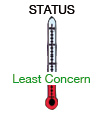ColorFrom a distance, Cormorants are dark birds with snaky necks, but up-close they’re quite colorful. The skin on their face and throat is orange-yellow and their eyes have a striking aquamarine color with a mouth that is bright blue on the inside. White feathering (filoplumes) on the head occurs prior to breeding, a feature that gradually disappears after egg laying phase. The immature bird is brownish with paler underparts.
Average size80-90 cm tall, 1,5-2,5 kg, the wingspan is 130-160 cm
Age22 years old, only about 30% of fledged chicks reach the age of 3 years due to starvation or cold winters
Record size & age90 cm, and 3,5 kg and 24 years old
HabitatThe Cormorant is a coastal bird that forms breeding colonies of up to 3000 pairs nesting in trees or near water. At these breading areas the caustic faeces eventually kills all vegetation and a Cormorant nesting area is quite a sinister sight with skeleton-like dead trees. Once the colony leaves the site, the vegetation returns.
FoodA Cormorant’s diet consists of a wide variety of fish, with just a few insects, crustaceans or amphibians. On an average they need 400– 500g of food/day but the amount varies greatly depending on the season. Their hunting is not always successful and some fish are found wounded and scarred which can increase the risk of disease for the wounded fish. Sometimes Cormorants hunt together taking turns forcing schools of fish closer to the surface to swallow them whole head first. They can stay under the surface for less than half a minute, swimming about 7-8 m below the surface. The Cormorant may fly up to 20-30 km to find food.
ReproductionAge: Mature at 2-5 years old but most reproductive at 5-10 years old
Season: April-June
Number of eggs: 3-4 eggs
The male chooses the nest site and then attracts a female. Both mates work on the nest, with the male bringing most of the material and the female doing the building. The nest is large and bowl-shaped, built of finger size twigs, grasses, seaweed or reeds and becomes plastered with the birds' droppings. The eggs are incubated by both parents, who are seasonally monogamous, for about a month. The newly-hatched young have skins like black leather but later grow a curly, dark grey down. They are fed once a day by each parent with fish. The chicks are fledged at 5 - 8 weeks of age and leave the nest.
Human Impact and StatusThere are few species in the Baltic Sea area that evoke stronger feelings in people than the Cormorant. This is mostly due to their collective huge consumption of fish. It doesn’t only compete with humans for fish but it seriously decimates the fish stocks in the already fragile Baltic Sea. The Cormorant also destroys fishermen’s gear and temporarily alters nature in their colonies. Their slightly frightful appearance is not helping.
It is a bird that has come and gone in Europe since thousands of years. Now it is said by many to be an alien Chinese Cormorant species introduced artificially and a threat to biodiversity in Europe. Alien or not, since its full protection, a directive established by EU 1995, the increase in number in the Baltic Sea took off and have in recent years become explosive.
The return of the Cormorant is welcomed by ornithologists and conservationists. There are international and local administrative boards installed for a Conservation and Management Plan to assure equilibrium in the Eco-systems and minimize the increasing disruptive impact of Cormorants on fish stocks, fishing and aquaculture. There seems to be a discrepancy, however, between the protection of the Cormorant and the rapidly growing colonies that now constitutes a real threat to several of the Eco-systems in the Baltic Sea.
In for example Norway the Cormorant is an appreciated traditional game bird which is not the case in the Baltic Sea countries. It is not at all seen as a potential asset for it’s tasty meat.
As with many sea birds, Cormorants are affected by oil pollution when fishing in the location of an oil slick. Oil clogs their feathers, they are unable to fly and swim and, as a result, they drown. Birds may also die of poisoning if they swallow oil.
There are no natural predators that regularly hunt cormorants for food. Eagles will sometimes kill the young and may steal the food from the adults. Some nest robbers are Gulls, Crows and Foxes but this seems to be of marginal importance.
CLOSE 
 English:
English: Svenska:
Svenska: Suomi:
Suomi: По-русски:
По-русски:  Esti:
Esti: Lietuviškai:
Lietuviškai: Latviešu:
Latviešu: Polski:
Polski: German:
German: Dansk:
Dansk:





